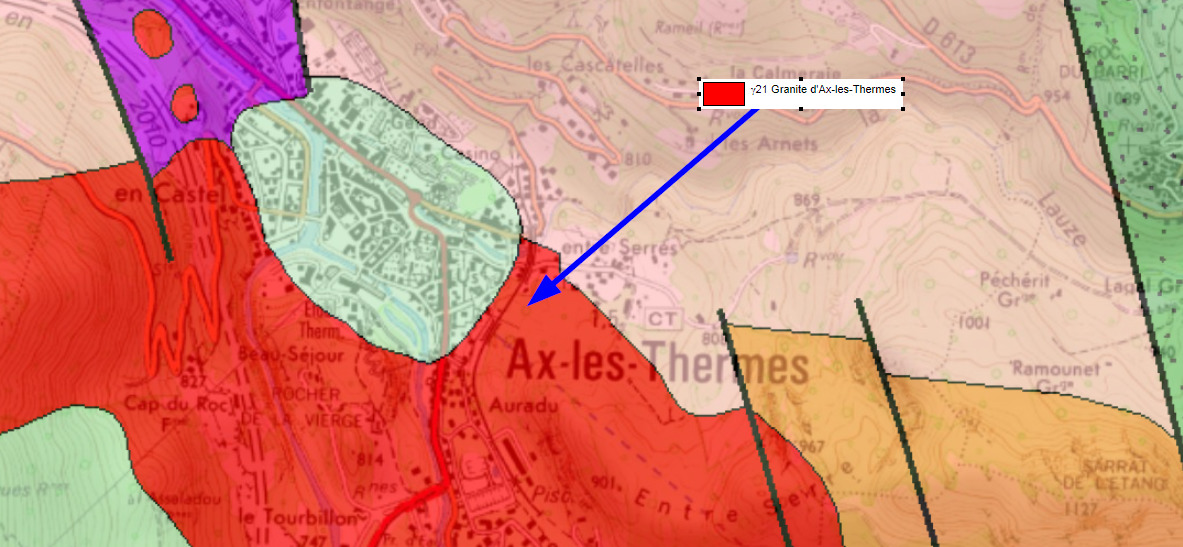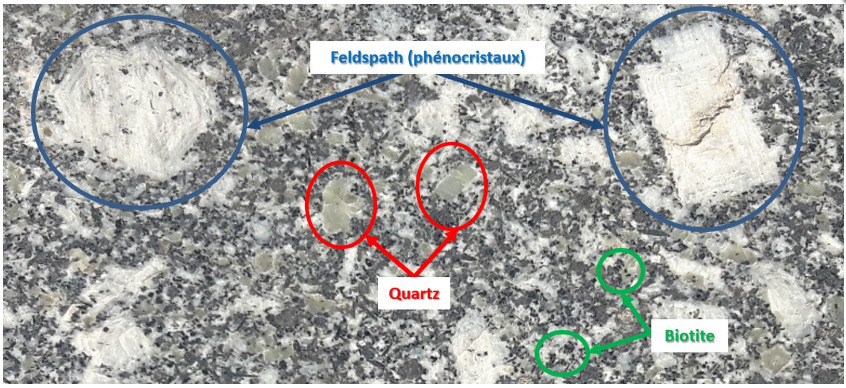
La Earthcache / The Earthcache
► Contexte géologique local
La ville d'Ax Les Thermes prend place au coeur de la zone axiale pyrénéenne sur un socle cristallin de roches plutoniques du Paléozoïque, un granite.

► Le granite, une roche QFM
Le granite est une formation cristalline plutôt claire, homogène, dure, non litée, provenant de la cristallisation en profondeur d'un magma.
Sa composition chimique majoritaire est de 3 minéraux aux initiales "QFM" :
- Q comme Quartz : translucide parfois transparent, ce minéral est de couleur gris sans facette.
- F comme Feldspath : blanchâtre ou rose, ce minéral est opaque et souvent en macles.
- M comme Mica : noir ou blanc, ce minéral se présente en fines lamelles brillantes.
La roche a une texture grenue dont la taille des grains est directement liée à la vitesse de cristallisation : plus les cristaux sont gros, plus la vitesse de cristallisation est lente.
Dans le cas les plus extrêmes, les plus gros cristaux, généralement des cristaux rectangulaires translucides de feldspaths alcalins, dépassent un centimètre de long et sont appelés des phénocristaux.
On parle alors de granite à texture porphyroïde.

Ce socle présente un système hydrothermaliste particulier.
► Les eaux sulfurées d'Ax-les-Thermes
Les mouvements tectoniques relatifs à l'orogenèse pyrénéenne ont entrainé la mise place d'un système de failles et de diaclases.
Les eaux de pluies s'infiltrent dans le massif granitique à 4000 mètres de profondeur et atteignent 120°C en se chargeant de sulfures, sodium, chlore.
Elles remontent ensuite rapidement depuis ces grandes profondeurs par les fractures du granite en bordure de l'encaissant imperméable et schisteux du pluton granitique, au point bas topographique, d'où une température élevée à l'émergence.
Ces résurgences d'eaux hydrothermales présentent plusieurs caractéristiques :
- des eaux sulfurées à fortes odeurs caractéristiques (parfum d’œuf pourri), l'odeur étant plus ou moins tenace selon la température et le teneur en soufre de l'eau.
- des eaux sodiques et alcalines.
- des eaux thérapeutiques.
► Local geological context
The town of Ax Les Thermes takes place in the heart of the Pyrenean axial zone on a crystalline base of Paleozoic plutonic rocks, a granite.
► Granite, a QFM rock
Granite is a rather clear, homogeneous, hard, unbedded crystalline formation resulting from the deep crystallization of a magma.
Its main chemical composition is 3 minerals with the initials "QFM":
- Q for Quartz: translucent sometimes transparent, this mineral is gray in color without facets.
- F for Feldspar: whitish or pink, this mineral is opaque and often twinned.
- M for Mica: black or white, this mineral comes in thin shiny strips.
The rock has a grainy texture whose grain size is directly related to the rate of crystallization: the larger the crystals, the slower the rate of crystallization.
In the most extreme cases, the largest crystals, usually translucent rectangular crystals of alkali feldspars, exceed one centimeter in length and are called phenocrysts.
We then speak of granite with a porphyroid texture.
This base has a particular hydrothermal system.
► The sulphurous waters of Ax-les-Thermes
The tectonic movements relating to the Pyrenean orogeny led to the establishment of a system of faults and joints.
The rainwater infiltrates the granite massif around 4000 meters deep and reaches 120°C, taking on sulphides, sodium and chlorine.
They then rise rapidly from these great depths through the fractures of the granite on the edge of the impermeable and schistose rock formation of the granitic pluton, at the topographic low point, resulting in a high temperature at emergence.
These resurgences of hydrothermal waters have several characteristics:
- sulphurous water with strong characteristic odors (rotten egg scent), the smell being more or less persistent depending on the temperature and the sulfur content of the water.
- sodium and alkaline waters.
- therapeutic waters.
► Sources bibliographiques / Bibliographical sources
Les Questions / The Questions
Questions pour valider :"Roches et Eaux à Ax-Les-Thermes"
Questions to validate: "Rocks and Waters in Ax-Les-Thermes"
- Question 0 : Prenez une photo de vous ou d'un élément sur site, sans montrer les zones d'observation.
Cette photo devra au choix nous être transmise avec les réponses ou être ajoutée à votre log.
-Question 0 : Take a photo of yourself or an element on site, without showing the observation areas.
This photo must either be sent to us with the answers or added to your log.
Point 1 : N 42° 43.178 E 001° 50.250
Vous traversez un endroit où se produit un bien étrange phénomène...
You cross a place where a very strange phenomenon occurs...
- Question 1 : Quel phénomène observez vous au WP1 ? Expliquez l'odeur que vous pouvez sentir.
- Question 1: What phenomenon do you observe at WP1? Explain the smell you can smell.
Point 2 : N 42° 43.168 E 001° 50.244
Vous voici devant un panneau présentant les eaux thermales d'Ax-Les-Thermes.
Here you are in front of a panel presenting the thermal waters of Ax-Les-Thermes.
- Question 2 : Quel record détient l'eau qui jaillit à Ax-les-Thermes ? Comment expliquer ce record ?
- Question 2: What record holds the water that gushes out at Ax-les-Thermes? How to explain this record?
Point 3 : N 42° 43.162 E 001° 50.236
Vous voici devant un vaste bassin peu profond où coule une eau légèrement fumante.
Here you are in front of a vast shallow pool where slightly steaming water flows.
- Question 3 : Décrivez la roche servant de margelle à ce bassin et identifiez sa nature. A t-elle pu être extraite dans les carrières des environs ?
- Question 3: Describe the rock serving as a rim for this basin and identify its nature. Could it have been extracted in the surrounding quarries?
- Question 4 : Quelle est la taille des plus gros cristaux de cette formation ? Déduisez-en ses conditions de formation en terme de refroidissement.
- Question 4: What is the size of the largest crystals in this formation? Deduce its formation conditions in terms of cooling.
Vous pouvez vous loguer sans attendre notre confirmation,
mais vous devez nous envoyer les réponses en même temps soit par mail via notre profil (
fafahakkai), soit via la messagerie geocaching.com (Message Center).
S'il y a des problèmes avec vos réponses nous vous en ferons part.
Les logs enregistrés sans réponse seront supprimés.You can log this cache without waiting for our confirmation, but you must send us the answers at the same time, by e-mail via our profile (fafahakkai) or by the system of Message Center of geocaching.com.
If there is a problem with your answers we will notify you. The logs recorded without answers will be deleted.
Rappel concernant les « Earthcaches »: Il n'y a pas de conteneur à rechercher ni de logbook à renseigner. Il suffit de se rendre sur les lieux, de répondre aux questions ci-dessus et de nous renvoyer les réponses.
Reminder concerning "Earthcaches": there is neither a container to look for nor a logbook to sign. One need only go to the location, answer to the differents questions and send us the answers.